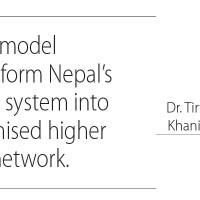- Sunday, 7 December 2025
Bridge, roads to ease pilgrimage to Damodar Kunda
BY HARI KRISHNA SHARMA,Mustang, Nov. 15: Pilgrims visiting the sacred Damodar Kunda in Ward No. 4 of Lo-Ghekar Damodarkunda Rural Municipality in Upper Mustang will soon be able to complete their pilgrimage and return in a single day thanks to the ongoing infrastructure expansion project.
Roads and a suspension bridge are being constructed to provide safer and more accessible travel for both domestic and international visitors, reducing the risk of altitude sickness and accidents.
A new suspension bridge, measuring 450 metres, will span the Bharsya River at an altitude of 5,500 metres above sea level between Nyumala Danda and Ghasyala Danda.
“The terrain here is extremely steep and challenging, and pilgrims often fell sick or got stranded in the past,” said Bishnu Prasad Bhusal, Chief District Officer and Chairman of the Muktinath Temple Management Committee. He added that the bridge is expected to cut a five-hour journey to two hours to reach Damodar Kunda on foot. But it may take three hours to return.
Around four kilometres of road from Yarghar to the bridge site are being widened, supported by the local community. “This will help prevent overnight stays and reduce the risk of altitude sickness for elderly and young pilgrims alike,” Bhusal said. The estimated budget for the road and suspension bridge is around Rs. 3 million.
Currently, pilgrims must travel along the Jomsom-Korala road of the Kaligandaki corridor and then take a two-hour ride to Jhuma Thati. Due to the difficult terrain, many rely on horses for part of the journey.
The Damodar Kunda area falls under the Muktinath Development Committee, which has also allocated Rs. 10 million to establish a study centre for research and education for Hindu and Buddhist visitors.
Damodar Kunda located at an altitude of 4,890 metres, is considered the head of the Muktikshetra and the source of the Kali Gandaki River. It is also the origin of the sacred Shaligram stones. It is a popular destination for both Nepali and Indian pilgrims. Visitors from outside Nepal, including Indians, require special entry permits of 500 US dollars for a 10-day stay.
The Kunda comprises three sacred water bodies: Chakrakunda, Dudhkunda, and Tamakunda, with Chakrakunda serving as the main bathing site where devotees perform ritual purification. Pilgrims also carry Shaligram stones and holy water back home, believing it brings blessings. During winter, the local dharmashala provides food, clothing, and shelter for those stranded due to snow, ensuring a safe pilgrimage experience.
With the completion of the bridge and road, the pilgrimage to Damodar Kunda is expected to become significantly safer, more accessible, and more convenient for thousands of visitors each year.














